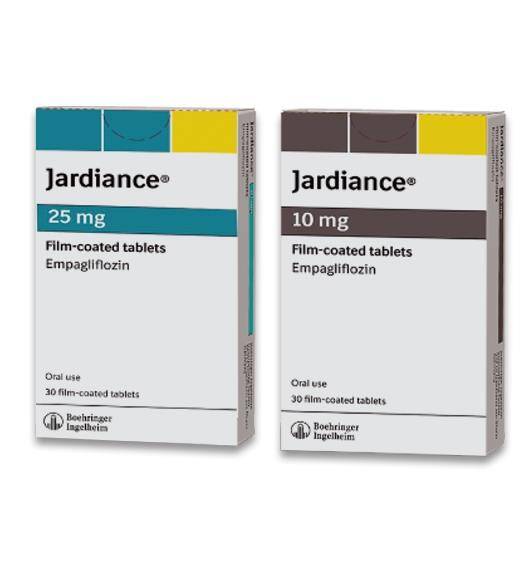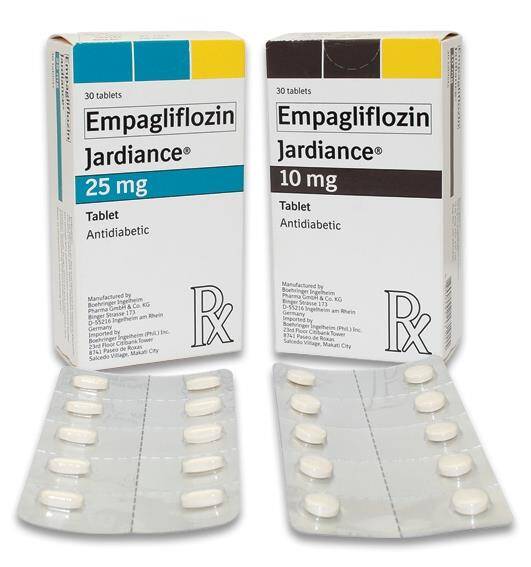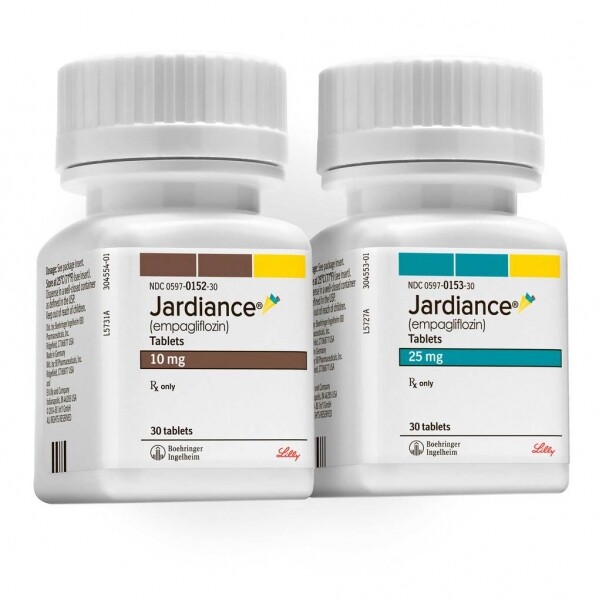- What Are Jardiance (Empagliflozin) 10mg, 25mg Tablets?
- Mechanism of Action
- Ingredients
- What Are the Dosages of Jardiance (Empagliflozin) 10mg, 25mg Tablets?
- Important Safety Information
- Prescription
- Contraindications to Jardiance Tablets
- Side Effects
- Interactions of Jardiance With Other Medicines
- Overdose of Empagliflozin
- Storage
- Benefits of Jardiance
- Empagliflozin Brand Names in Different Countries
Living with diabetes can present challenges, but with the right tools, managing your condition can become more achievable and rewarding. Jardiance (Empagliflozin) tablets are a remarkable advancement in treating type 2 diabetes.

What Are Jardiance (Empagliflozin) 10mg, 25mg Tablets?
Jardiance is an innovative medication that belongs to a class of drugs known as SGLT2 inhibitors. Designed specifically for adults with type 2 diabetes, Jardiance offers a unique approach to managing blood glucose levels effectively.
Jardiance is typically prescribed as part of a comprehensive treatment plan for type 2 diabetes, including lifestyle changes, such as a healthy diet, regular exercise, and other diabetes medications.
Jardiance has undergone rigorous clinical trials, ensuring its safety and efficacy for people with type 2 diabetes. However, consult your healthcare provider to determine if Jardiance is the right choice for you, considering your unique medical history and current treatment plan.
NDC Code(s): 0597-0152-07, 0597-0152-30, 0597-0152-37, 0597-0152-70.
Mechanism of Action
Jardiance works by targeting a protein in the kidneys called SGLT2. By inhibiting the action of SGLT2, Jardiance helps to prevent the reabsorption of glucose, allowing excess glucose to be excreted through the urine. This mechanism assists in reducing blood glucose levels and promotes better glycemic control.
Additionally, Jardiance has been shown to have beneficial effects on the cardiovascular system. Clinical trials have demonstrated that empagliflozin reduces the risk of cardiovascular death, heart failure, hospitalization, and cardiovascular events in patients with type 2 diabetes and established cardiovascular disease.
Overall, Jardiance’s mechanism of action helps to lower blood glucose levels, promote weight loss, and potentially improve cardiovascular outcomes in individuals with type 2 diabetes. As with any medication, following the prescribed dosage and consulting your healthcare provider for specific information and guidance is essential.
Ingredients
The active ingredient in Jardiance tablets is empagliflozin. Each tablet of Jardiance contains:
- Empagliflozin – 10mg or 25mg;
- Excipients – q.s.
What Are the Dosages of Jardiance (Empagliflozin) 10mg, 25mg Tablets?
Jardiance (empagliflozin) tablets are available in two different strengths: 10mg and 25mg. These strengths indicate the amount of empagliflozin present in each tablet. The dosage of Jardiance prescribed to an individual will depend on various factors, including their specific medical condition, response to treatment, and the healthcare professional’s assessment.
For most adults with type 2 diabetes, the recommended starting dose of Jardiance is usually 10mg taken orally once daily. This initial dose can be adjusted based on individual response and tolerability. Your healthcare provider may increase or decrease the dosage as necessary to achieve the desired blood glucose control.
In some cases, a higher strength of Jardiance tablets, such as the 25mg strength, may be prescribed if additional glycemic control is needed or if the lower dose is insufficient for an individual’s needs. However, a healthcare professional should always determine the dosage based on the individual’s specific circumstances.

Important Safety Information
Jardiance can increase the risk of developing a serious condition called ketoacidosis, a potentially life-threatening complication. Symptoms may include excessive thirst, frequent urination, nausea, vomiting, abdominal pain, fatigue, and difficulty breathing. If any of these symptoms occur, medical attention should be sought immediately.
The tablets may increase the risk of genital mycotic (fungal) infections, such as yeast infections in women and balanitis in men. Maintaining good hygiene and reporting any signs of infection, such as itching, burning, or discharge, to your healthcare provider is essential.
This medicine may also increase the risk of urinary tract infections. Symptoms may include pain or a burning sensation during urination, frequent urination, or cloudy urine. If you experience these symptoms, contact your healthcare provider.
Jardiance can lead to low blood pressure (hypotension), especially in patients who are elderly, have renal impairment, or are taking medications that lower blood pressure. Dehydration may also occur, especially in individuals with inadequate fluid intake or those taking diuretics. Signs of dehydration include excessive thirst, dizziness, lightheadedness, or fainting. Maintaining adequate hydration and reporting any symptoms to your healthcare provider is essential.
This medication may affect kidney function and cause changes in renal laboratory parameters. Regular monitoring of kidney function is recommended.
Jardiance, when used alone or in combination with other antidiabetic medications, may increase the risk of hypoglycemia (low blood sugar). Closely monitor blood sugar levels, especially when Jardiance is combined with insulin or insulin secretagogues.
Common side effects of the tablets may include urinary tract infections, genital mycotic infections, increased urination, and increased thirst. However, this is a partial list, and other side effects may occur. Consult your healthcare provider for a complete list of possible side effects.
The safety of pills has not been established in pregnant or breastfeeding women. Consult your healthcare provider if you are pregnant, planning to become pregnant, or breastfeeding before taking Jardiance.
This is a partial list of safety information. Discuss any concerns with your healthcare provider before starting Jardiance treatment.
Prescription
Jardiance (empagliflozin) is a prescription medication, which means you need a prescription from a healthcare provider to buy it. This is because Jardiance is a potent medication for treating type 2 diabetes, requiring proper medical evaluation, monitoring, and individualized dosing.
To obtain a prescription for Jardiance, you must consult a healthcare professional, such as a primary care physician, endocrinologist, or a healthcare provider specializing in diabetes management.
Follow your healthcare provider’s prescribed dosage and instructions when taking Jardiance or any other prescription medication.
Contraindications to Jardiance Tablets
There are specific contraindications to the use of Jardiance (empagliflozin) tablets. Contraindications refer to specific situations or medical conditions in which medication use is not recommended due to potential risks or adverse effects. Here are some contraindications to consider:
- Hypersensitivity: Jardiance is contraindicated in individuals who have had a hypersensitivity reaction to empagliflozin or any of the components of the medication. Signs of hypersensitivity may include rash, itching, swelling, or difficulty breathing.
- Severe Renal Impairment or End-Stage Renal Disease: Jardiance is not recommended for individuals with severe renal impairment (estimated glomerular filtration rate [eGFR] less than 30 mL/min/1.73 m²) or those with end-stage renal disease (ESRD) requiring dialysis. This is because Jardiance is primarily excreted through the kidneys, and impaired renal function may affect the clearance of the medication.
- Diabetic Ketoacidosis: Jardiance is contraindicated in diabetic ketoacidosis (DKA), a severe condition characterized by high blood ketone levels and metabolic acidosis. Jardiance should not be initiated or continued in individuals with DKA.
- Type 1 Diabetes: Jardiance is specifically indicated for treating type 2 diabetes and should not be used in individuals with type 1 diabetes.
- Pregnancy: The safety of Jardiance during pregnancy has not been established, and it is generally not recommended for use during pregnancy. If you are pregnant, planning to become pregnant or suspect you may be pregnant, you should discuss the potential risks and benefits of Jardiance with your healthcare provider.
- Breastfeeding: It is not known whether Jardiance is excreted in human breast milk. Therefore, caution should be exercised when considering Jardiance while breastfeeding. Consult with your healthcare provider for personalized advice.
This is not an exhaustive list of contraindications. Always consult your healthcare provider to determine if Jardiance is safe and appropriate for your specific medical condition,
Side Effects
Empagliflozin tablets may cause side effects in some individuals. Not everyone will experience these side effects, and their severity can vary. Common side effects and adverse reactions associated with Jardiance include:
- Tablets may increase the risk of genital mycotic (fungal) infections, such as yeast infections in women and balanitis in men. Symptoms may include itching, burning, redness, or discharge in the genital area.
- The medicine may also increase the risk of urinary tract infections. Symptoms may include pain or a burning sensation during urination, frequent urination, or cloudy urine.
- The medication, combined with insulin or insulin secretagogues, may increase the risk of hypoglycemia (low blood sugar). Symptoms may include sweating, dizziness, shakiness, confusion, or hunger.
- Jardiance can lead to dehydration and low blood pressure (hypotension), especially in individuals who are elderly, have renal impairment, or are taking medications that lower blood pressure. Signs of dehydration may include excessive thirst, dry mouth, weakness, dizziness, or reduced urine output.
- The tablets work by increasing the excretion of glucose in the urine, which can lead to increased urination and thirst.
- Although rare, Jardiance can increase the risk of developing ketoacidosis, a severe condition characterized by high ketone levels and metabolic acidosis. Symptoms may include excessive thirst, frequent urination, nausea, vomiting, abdominal pain, fatigue, or difficulty breathing.
- The medication may cause changes in renal laboratory parameters, including decreased kidney function. Regular monitoring of kidney function is recommended.
- There have been reports of bone fractures in patients taking Jardiance. It is advised to consider factors such as bone health and fracture risk before initiating or continuing treatment with Jardiance.
- In rare cases, Jardiance may cause allergic reactions, including rash, itching, swelling, or difficulty breathing. Seek immediate medical attention if you experience any signs of an allergic reaction.
You must report any side effects or adverse reactions to your healthcare provider.

Interactions of Jardiance With Other Medicines
Empagliflozin may interact with other medicines, including prescription medications, over-the-counter drugs, and herbal supplements. These interactions can affect the effectiveness of the medication or increase the risk of side effects. Inform your healthcare provider about all the medications you are currently taking to ensure safe and appropriate use. Here are some notable interactions:
- Diuretics (Water Pills): Concurrent use of Jardiance with diuretics may increase the risk of dehydration and low blood pressure. If you take diuretics, your healthcare provider may need to monitor your blood pressure and kidney function more closely.
- Insulin and Insulin Secretagogues: Jardiance, combined with insulin or insulin secretagogues (e.g., sulfonylureas), may increase the risk of hypoglycemia (low blood sugar). Dose adjustments of these medications may be necessary to prevent low blood sugar levels.
- Medications that Lower Blood Pressure: Jardiance can further lower blood pressure when used with other medications with a blood pressure-lowering effect. This includes antihypertensive drugs, such as ACE inhibitors, ARBs, and beta-blockers. Regular blood pressure monitoring is essential, and dosage adjustments may be needed.
- Medications that Affect Renal Function: Medications that affect kidney function, such as nonsteroidal anti-inflammatory drugs (NSAIDs), may interact with Jardiance and increase the risk of renal impairment. Using caution and discussing potential risks with your healthcare provider is recommended.
- Digoxin: Jardiance may increase the concentration of digoxin in the blood. Close monitoring of digoxin levels and any associated side effects is advisable when taking Jardiance concurrently.
- Rifampin: Rifampin, an antibiotic used to treat tuberculosis and other infections, may decrease the concentration of Jardiance in the blood. Your healthcare provider may need to adjust the Jardiance dosage if you also take rifampin.
These are not all the possible interactions of the medication. Other medications and substances may interact with Jardiance, so you must disclose all your medications, including over-the-counter drugs and herbal supplements, to your healthcare provider.
Overdose of Empagliflozin
If you suspect an overdose of empagliflozin, seek immediate medical attention or contact a poison control center. An overdose can be a severe medical emergency that requires prompt medical intervention.
Signs and symptoms of an empagliflozin overdose may include:
- Hypoglycemia (low blood sugar): sweating, dizziness, shakiness, confusion, irritability, weakness, or fainting.
- Dehydration: excessive thirst, dry mouth, weakness, dizziness, reduced urine output, or dark-colored urine.
- Electrolyte imbalances: muscle cramps, irregular heartbeat, weakness, or fatigue.
It’s important to note that the information provided here is for general knowledge, and healthcare professionals should determine specific actions in the case of an overdose.
To prevent an overdose, it is essential to take empagliflozin as prescribed by your healthcare provider and follow the recommended dosage instructions. Do not modify the dosage without consulting your healthcare provider, and always promptly report any concerning symptoms or side effects to your healthcare provider.
Storage
Store Jardiance tablets at room temperature, ideally between 20°C to 25°C (68°F to 77°F). Keep the tablets in a dry place and protect them from moisture. Avoid storing them in the bathroom, where humidity levels can be higher. Protect Jardiance from excessive light. Keep the tablets in their original packaging to protect them from light exposure. Ensure that Jardiance is stored securely, out of the reach of children and pets. The medication should only be accessed by individuals for whom it is prescribed.
Benefits of Jardiance
- Blood Glucose Control: Jardiance is proven to help lower blood glucose levels, providing a valuable tool in managing diabetes effectively.
- Weight Management: With Jardiance, you may experience weight loss as excess calories are eliminated through the urine, contributing to your overall well-being.
- Cardiovascular Health: Jardiance has demonstrated impressive cardiovascular benefits, reducing the risk of cardiovascular death, heart failure hospitalization, and other cardiovascular events. It’s an extra layer of protection for your heart health.
Empagliflozin Brand Names in Different Countries
Here’s a table showing the brand names of empagliflozin in different countries:
| Country | Brand Names |
| United States | Jardiance |
| Glyxambi | |
| Synjardy | |
| Synjardy XR | |
| Gibtulio | |
| Canada | Jardiance |
| Glyxambi | |
| Synjardy | |
| Synjardy XR | |
| United Kingdom | Jardiance |
| Glyxambi | |
| Synjardy | |
| Australia | Jardiance |
| Glyxambi | |
| European countries | Jardiance |
| Japan | Ajugla |
Please note that new medicine may appear in 2023. Verifying the latest brand names with local healthcare professionals or pharmacists in specific countries is recommended.



































